The Influence of the Interface on the Micromechanical Behavior of Unidirectional Fiber-Reinforced Ceramic Matrix Composites: An Analysis Based on the Periodic Symmetric Boundary Conditions
Abstract
:1. Introduction
2. Materials and Methods
2.1. Construction of Microscopic Representative Volume Element
2.2. Periodic Symmetric Boundary Condition
2.3. Ceramic Matrix Phase-Field Damage Model
2.4. Fiber/Matrix Cohesive Model
3. Results and Discussion
3.1. Validation of the RVE Model Effectiveness
3.2. Impact of Interfacial Strength on Mechanical Behavior under Uniaxial Loading
3.3. Impact of Interfacial Toughness on Mechanical Behavior under Uniaxial Loading
3.4. The Impact of the Interfacial Strength on the Failure Envelope under Biaxial Loading
4. Conclusions
Author Contributions
Funding
Data Availability Statement
Conflicts of Interest
References
- Braun, J.; Sauder, C. Mechanical behavior of SiC/SiC composites reinforced with new Tyranno SA4 fibers: Effect of interphase thickness and comparison with Tyranno SA3 and Hi-Nicalon S reinforced composites. J. Nucl. Mater. 2022, 558, 153367. [Google Scholar] [CrossRef]
- Karadimas, G.; Salonitis, K. Ceramic matrix composites for aero engine applications—A review. Appl. Sci. 2023, 13, 3017. [Google Scholar] [CrossRef]
- Fang, G.; Gao, X.; Song, Y. A review on ceramic matrix composites and environmental barrier coatings for aero-engine: Material development and failure analysis. Coatings 2023, 13, 357. [Google Scholar] [CrossRef]
- Huang, R.; Deng, J.; Ma, X.; Mao, Y.; Fan, S. Modifying C/C–SiC brake pads with different Fe–Si alloy phases to improve the wear resistance of full-carbon/ceramic brake pair. Ceram. Int. 2024, 50, 10582–10592. [Google Scholar] [CrossRef]
- Detwiler, K.; Hunt, R.; Opila, E. In-situ observation of micro-cracking in a SiC/BN/SiC ceramic matrix composite under tension. Open Ceram. 2023, 14, 100366. [Google Scholar] [CrossRef]
- Chen, M.; Qiu, H.; Zhao, Y.; Zhang, B.; Liu, S.; Luo, W.; Ma, X.; Xie, W.; Chen, Y.; Zhang, Q.; et al. Effect of BN interfacial layer on the mechanical behavior of SiC fiber reinforced SiC ceramic matrix composites. Int. J. Appl. Ceram. Technol. 2024, 21, 1892–1904. [Google Scholar] [CrossRef]
- Hu, P.; Cheng, Y.; Xie, M.; Wang, H. Damage mechanism analysis to the carbon fiber and fiber-ceramic interface tailoring of Cf/ZrC-SiC using PyC coating. Ceram. Int. 2018, 44, 19038–19043. [Google Scholar] [CrossRef]
- Qin, L.; Luo, R. Influence of Pyrolytic Carbon on the Properties of Precursor-Impregnated and Pyrolyzed 3D-Cf/SiC Composites. China Ceram. Ind. 2018, 25, 1–6. [Google Scholar]
- Liu, H.T.; Yang, L.W.; Sun, X.; Cheng, H.F.; Wang, C.Y.; Mao, W.G.; Molina-Aldareguia, J.M. Enhancing the fracture resistance of carbon fiber reinforced SiC matrix composites by interface modification through a simple fiber heat-treatment process. Carbon 2016, 109, 435–443. [Google Scholar] [CrossRef]
- Spahn, J.; Andrä, H.; Kabel, M.; Müller, R. A multiscale approach for modeling progressive damage of composite materials using fast Fourier transforms. Comput. Methods Appl. Mech. Eng. 2014, 268, 871–883. [Google Scholar] [CrossRef]
- Patel, D.K.; Waas, A.M. Multiscale modeling of tensile fracture in fiber reinforced composites. Compos. Part C Open Access 2020, 2, 100016. [Google Scholar] [CrossRef]
- Sahu, S.K.; Rama Sreekanth, P.S. Multiscale RVE modeling for assessing effective elastic modulus of HDPE based polymer matrix nanocomposite reinforced with nanodiamond. Int. J. Interact. Des. Manuf. 2022, 1–10. [Google Scholar] [CrossRef]
- Wan, X.; Yang, G.; Zhao, M. Analysis of the Influence of Fiber Distribution and Interface Strength on the Transverse Compression Performance of Composite Materials. J. Northwestern Polytech. Univ. 2019, 37, 443–448. [Google Scholar] [CrossRef]
- Braginsky, M.; Przybyla, C.P. Simulation of crack propagation/deflection in ceramic matrix continuous fiber reinforced composites with weak interphase via the extended finite element method. Compos. Struct. 2016, 136, 538–545. [Google Scholar] [CrossRef]
- Tan, W.; Naya, F.; Yang, L.; Chang, T.; Falzon, B.; Zhan, L.; Molina-Aldareguía, J.; González, C.; Llorca, J. The role of interfacial properties on the intralaminar and interlaminar damage behaviour of unidirectional composite laminates: Experimental characterization and multiscale modelling. Compos. Part B Eng. 2018, 138, 206–221. [Google Scholar] [CrossRef]
- Vajari, D.A.; González, C.; Llorca, J.; Legarth, B.N. A numerical study of the influence of microvoids in the transverse mechanical response of unidirectional composites. Compos. Sci. Technol. 2014, 97, 46–54. [Google Scholar] [CrossRef]
- Feng, Y.; Wang, J.; Shang, N.; Zhao, G.; Zhang, C.; Tang, J.; Xin, S.; Hornig, A.; Gude, M.; Huang, Q.; et al. Multiscale Modeling of SiCf/SiC Nuclear Fuel Cladding Based on FE-Simulation of Braiding Process. Front. Mater. 2021, 7, 634112. [Google Scholar] [CrossRef]
- Brockenbrough, J.R.; Suresh, S.; Wienecke, H.A. Deformation of metal-matrix composites with continuous fibers: Geometrical effects of fiber distribution and shape. Acta Metall. Mater. 1991, 39, 735–752. [Google Scholar] [CrossRef]
- Naya, F.; González, C.; Lopes, C.; Van der Veen, S.; Pons, F. Computational micromechanics of the transverse and shear behavior of unidirectional fiber reinforced polymers including environmental effects. Compos. Part A Appl. Sci. Manuf. 2017, 92, 146–157. [Google Scholar] [CrossRef]
- Wang, L.; Zhang, Y. Interpreting correlations in stress-dependent permeability, porosity, and compressibility of rocks: A viewpoint from finite strain theory. Int. J. Numer. Anal. Methods Geomech. 2024, 48, 2000–2019. [Google Scholar] [CrossRef]
- Wan, L.; Ismail, Y.; Sheng, Y.; Ye, J. A review on micromechanical modelling of progressive failure in unidirectional fiber-reinforced composites. Compos. Part C Open Access 2023, 10, 100348. [Google Scholar] [CrossRef]
- Sauder, C. Ceramic matrix composites: Nuclear applications. In Ceramic Matrix Composites: Materials, Modeling and Technology; The American Ceramic Society: Columbus, OH, USA, 2014; pp. 609–646. [Google Scholar]
- Snead, L.L.; Nozawa, T.; Katoh, Y.; Byun, T.-S.; Kondo, S.; Petti, D.A. Handbook of SiC properties for fuel performance modeling. J. Nucl. Mater. 2007, 371, 329–377. [Google Scholar] [CrossRef]
- Zhang, D.; Zhao, L.G.; Roy, A. Mechanical behavior of silicon carbide under static and dynamic compression. J. Eng. Mater. Technol. 2019, 141, 011007. [Google Scholar] [CrossRef]
- Yang, L.W.; Liu, H.T.; Cheng, H.F. Processing-temperature dependent micro-and macro-mechanical properties of SiC fiber reinforced SiC matrix composites. Compos. Part B Eng. 2017, 129, 152–161. [Google Scholar] [CrossRef]
- Abdellahi, B.; Azhari, F.; Nguyen, P. Prediction of the failure behavior of pseudo-ductile composites using a multi-scale finite element model. Res. Sq. 2024. [Google Scholar] [CrossRef]
- Zhang, J.; Xie, J.; Zhao, X.; Chen, J.; Li, Z. Influence of void defects on impact properties of CFRP laminates based on multi-scale simulation method. Int. J. Impact Eng. 2023, 180, 104706. [Google Scholar] [CrossRef]
- Li, B.; Liao, J.; Chen, Z.; Liu, J.; Mao, B.; Huang, H.; Yuan, X. High-performance Cf/SiC composites with a novel needle-punched carbon fiber fabric fabricated by PIP process. Mater. Res. Express 2019, 6, 115622. [Google Scholar] [CrossRef]
- Konica, S.; Sain, T. Phase-field fracture modeling for unidirectional fiber-reinforced polymer composites. Eur. J. Mech.-A/Solids 2023, 100, 105035. [Google Scholar] [CrossRef]
- Feng, D.C.; Wu, J.Y. Phase-field regularized cohesive zone model (CZM) and size effect of concrete. Eng. Fract. Mech. 2018, 197, 66–79. [Google Scholar] [CrossRef]
- Yu, H.; Hao, L.; Shen, R.; Guo, L.; Shen, Z.; Li, Y. A phase field model with the mixed-mode driving force of power-law relation. Eng. Fract. Mech. 2022, 264, 108265. [Google Scholar] [CrossRef]
- Griffith, A.A. VI. The phenomena of rupture and flow in solids. Philos. Trans. R. Soc. London. Ser. A Contain. Pap. A Math. Or Phys. Character 1921, 221, 163–198. [Google Scholar]
- Wu, J.Y. A unified phase-field theory for the mechanics of damage and quasi-brittle failure. J. Mech. Phys. Solids 2017, 103, 72–99. [Google Scholar] [CrossRef]
- Wu, J.Y.; Nguyen, V.P. A length scale insensitive phase-field damage model for brittle fracture. J. Mech. Phys. Solids 2018, 119, 20–42. [Google Scholar] [CrossRef]
- Wu, J.Y.; Huang, Y.; Nguyen, V.P. On the BFGS monolithic algorithm for the unified phase field damage theory. Comput. Methods Appl. Mech. Eng. 2020, 360, 112704. [Google Scholar] [CrossRef]
- Barenblatt, G.I. Equilibrium cracks formed during brittle fracture rectilinear cracks in plane plates. J. Appl. Math. Mech. 1959, 23, 1009–1029. [Google Scholar] [CrossRef]
- Dugdale, D.S. Yielding of steel sheets containing slits. J. Mech. Phys. Solids 1960, 8, 100–104. [Google Scholar] [CrossRef]
- Linke, M.; Lammering, R. On the calibration of the cohesive strength for cohesive zone models in finite element analyses. Theor. Appl. Fract. Mech. 2023, 124, 103733. [Google Scholar] [CrossRef]
- Heidari-Rarani, M.; Sayedain, M. Finite element modeling strategies for 2D and 3D delamination propagation in composite DCB specimens using VCCT, CZM and XFEM approaches. Theor. Appl. Fract. Mech. 2019, 103, 102246. [Google Scholar] [CrossRef]
- Chamis, C.C. Mechanics of composite materials: Past, present and future. In Proceedings of the 21st Annual Meeting of the Society for Engineering Science, Blacksburg, VA, USA, 15–17 October 1984; p. E-3936. [Google Scholar]
- Yang, L. Study on the Damage and Failure Mechanisms of SiC/SiC Ceramic Matrix Composites; Harbin Institute of Technology: Harbin, China, 2019. [Google Scholar]
- Pu, J.; Wang, J.; Tang, J.; Shen, L. Multi-scale Progressive Damage and Failure Behavior Analysis of Three-Dimensional Winding SiC Fiber-Reinforced SiC Matrix Composite Tube. Appl. Compos. Mater. 2023, 30, 1605–1626. [Google Scholar] [CrossRef]
- Peng, P.; Zhao, M.; Wang, W. Study on Predicting Transverse Strength of Composites Using Micromechanical Models. Mech. Sci. Technol. 2017, 36, 1611–1618. [Google Scholar]
- Zhou, Q. Multiscale Mechanical Properties of 2D Braided Ceramic Matrix Composites; Harbin Institute of Technology: Harbin, China, 2020. [Google Scholar]
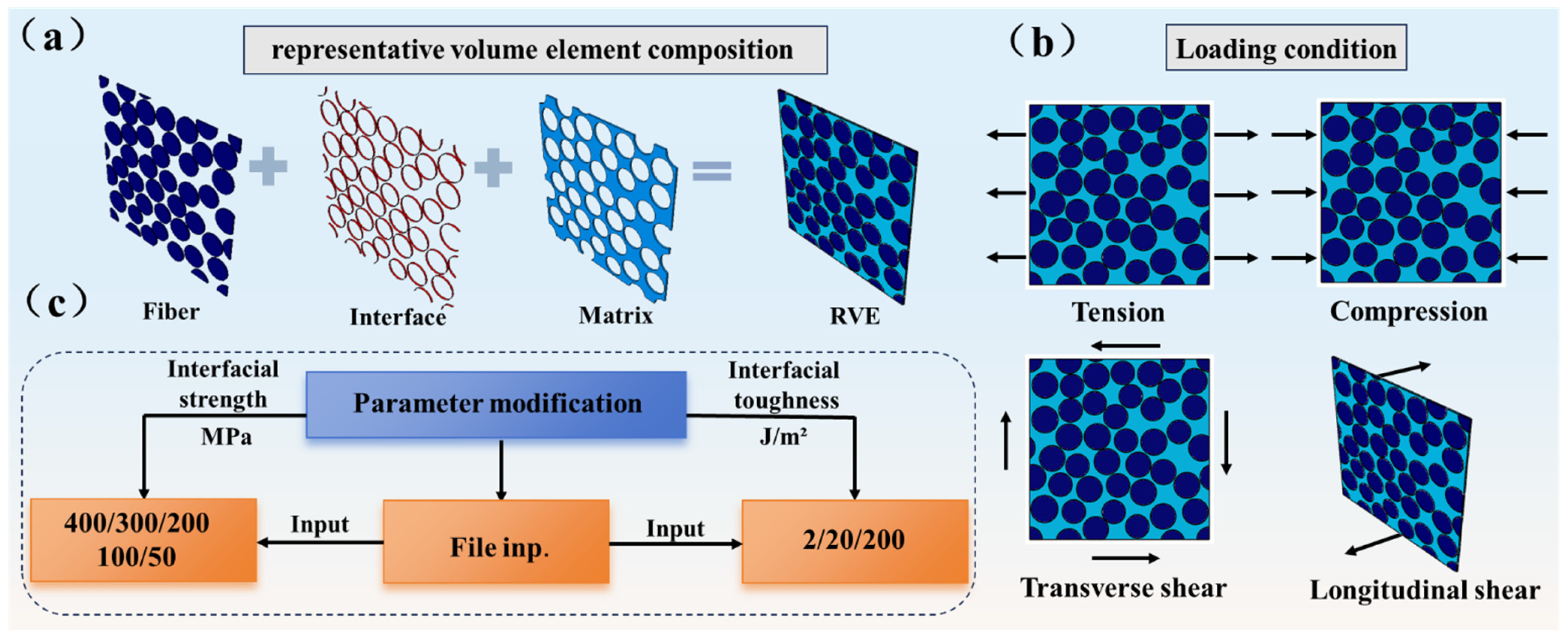
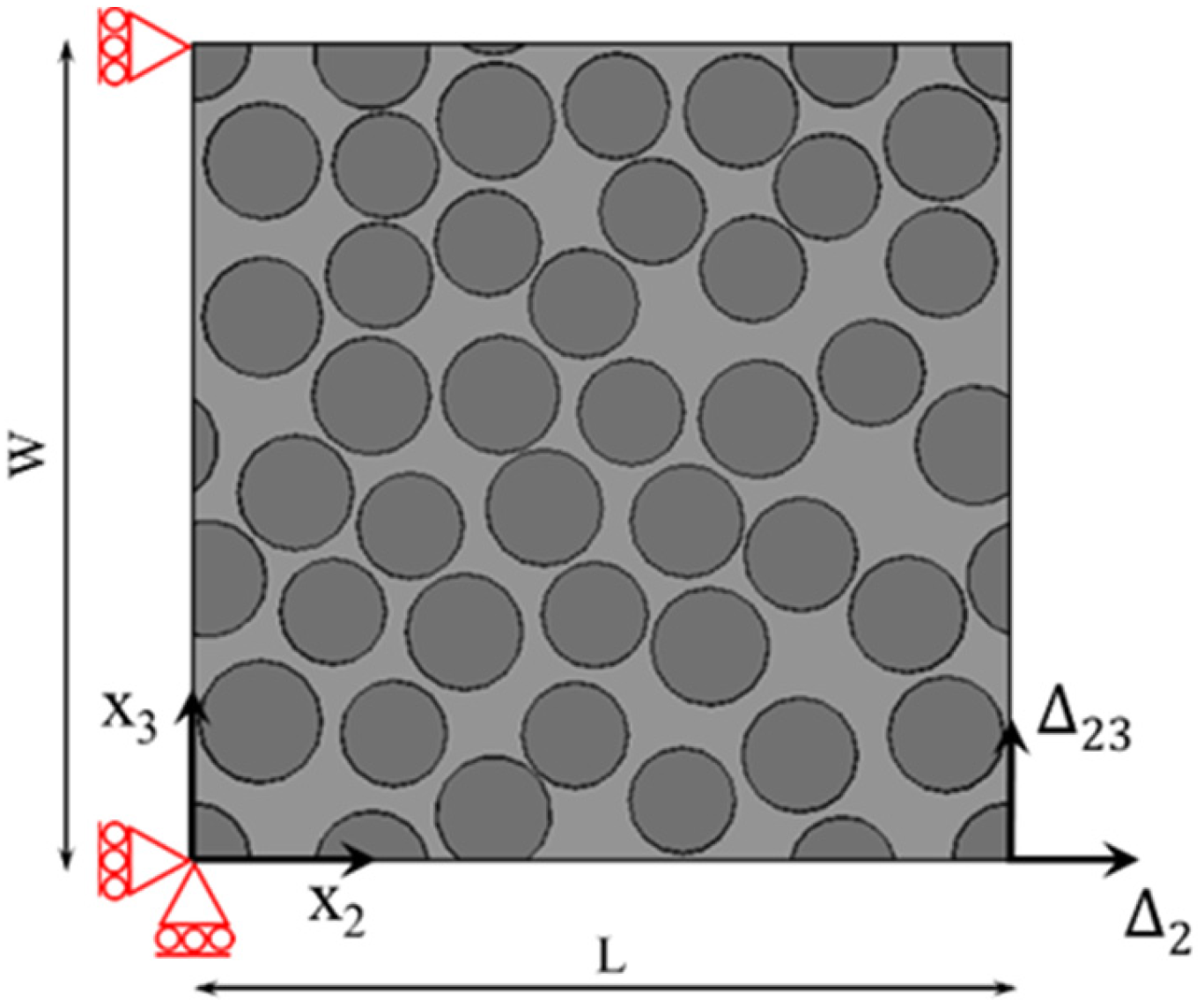
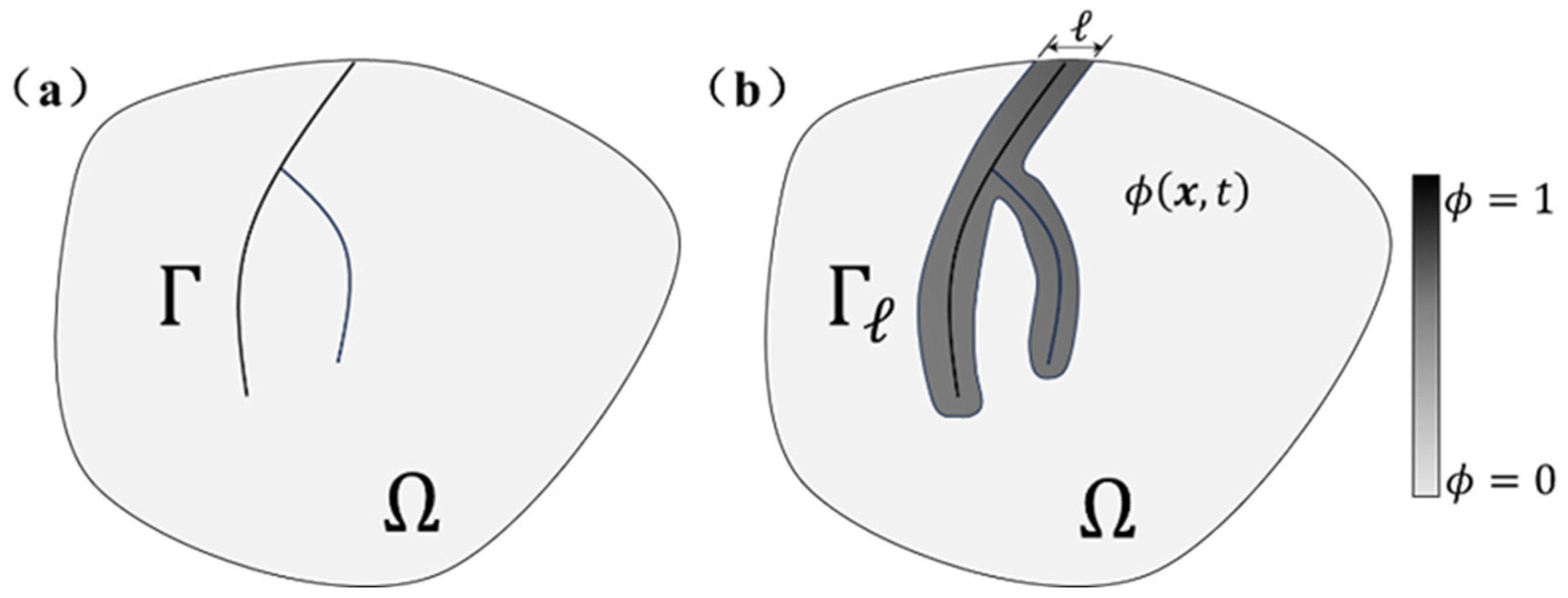
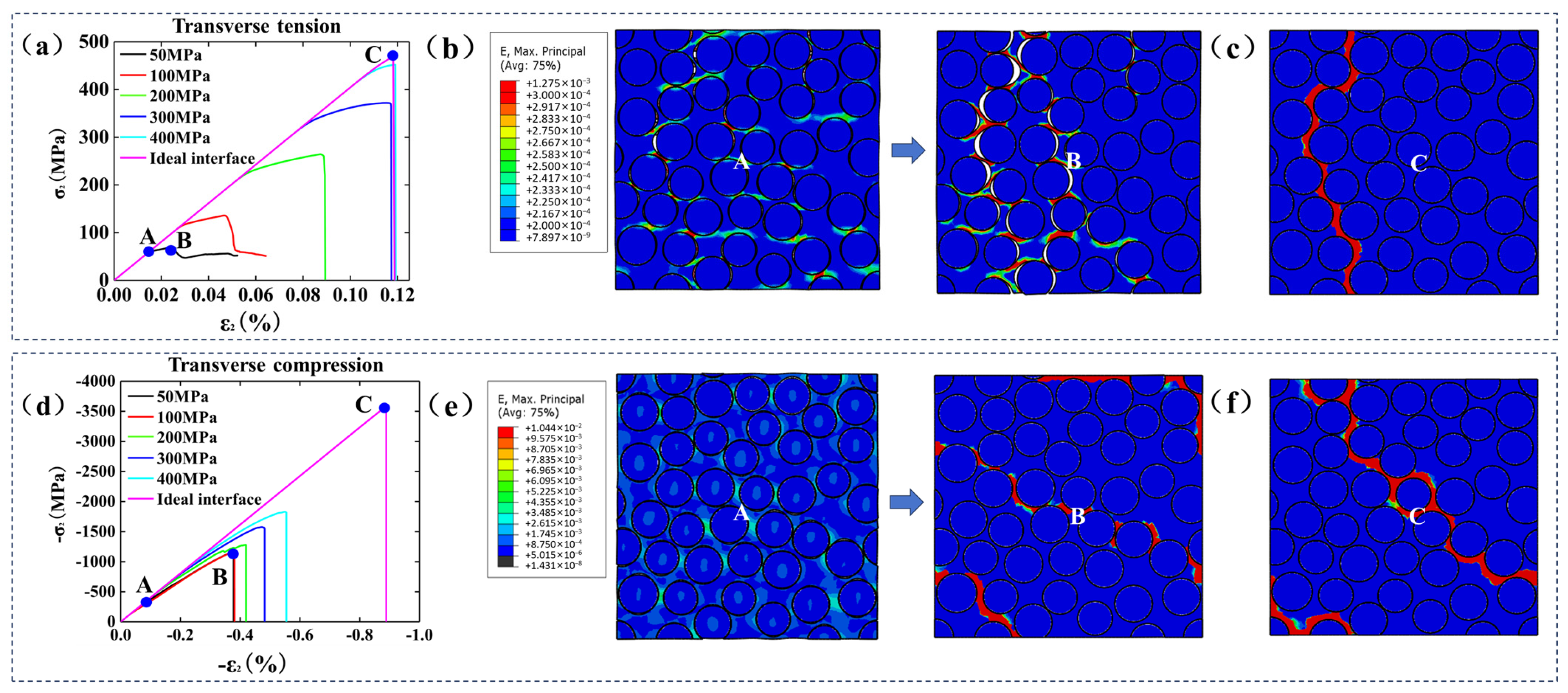

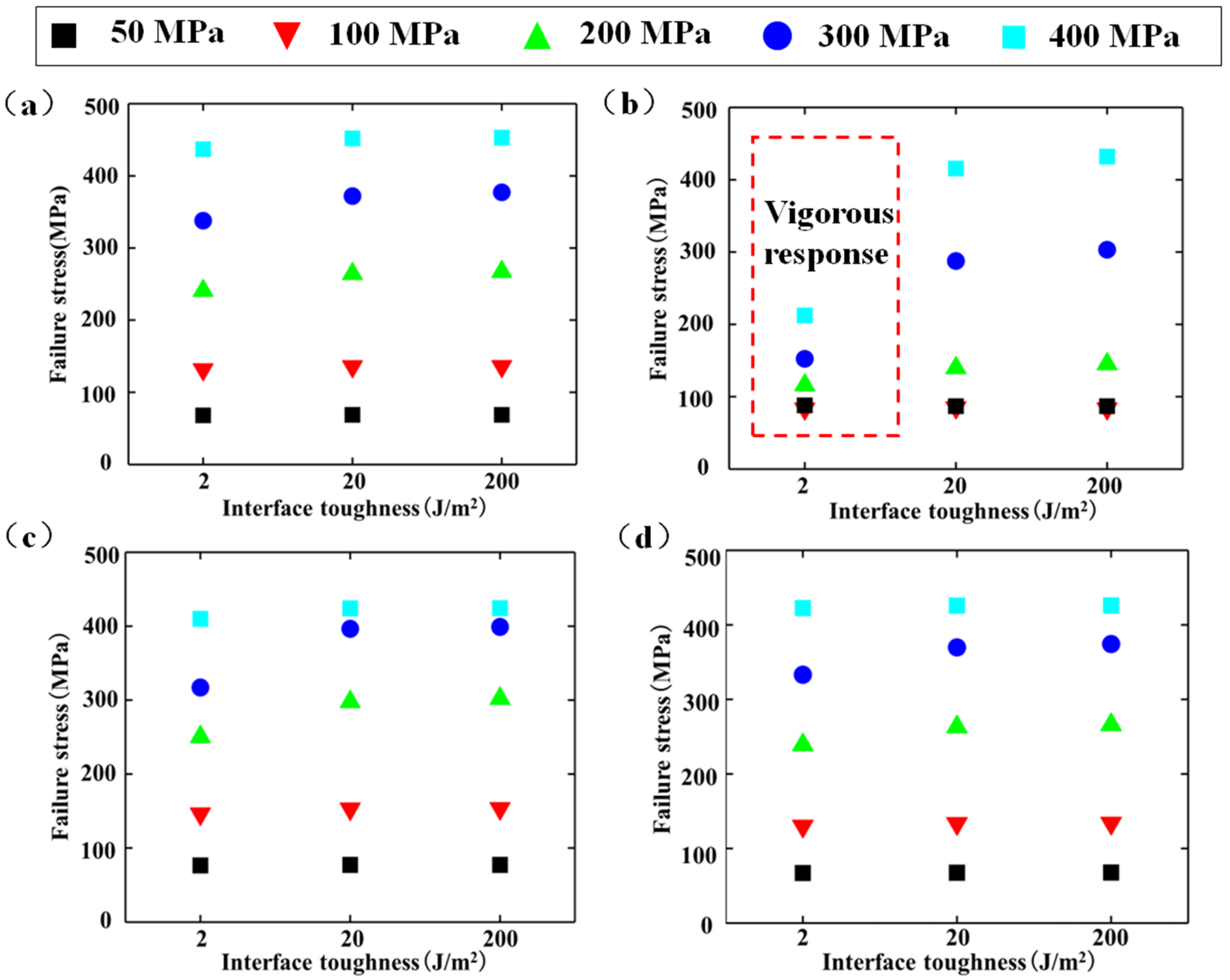
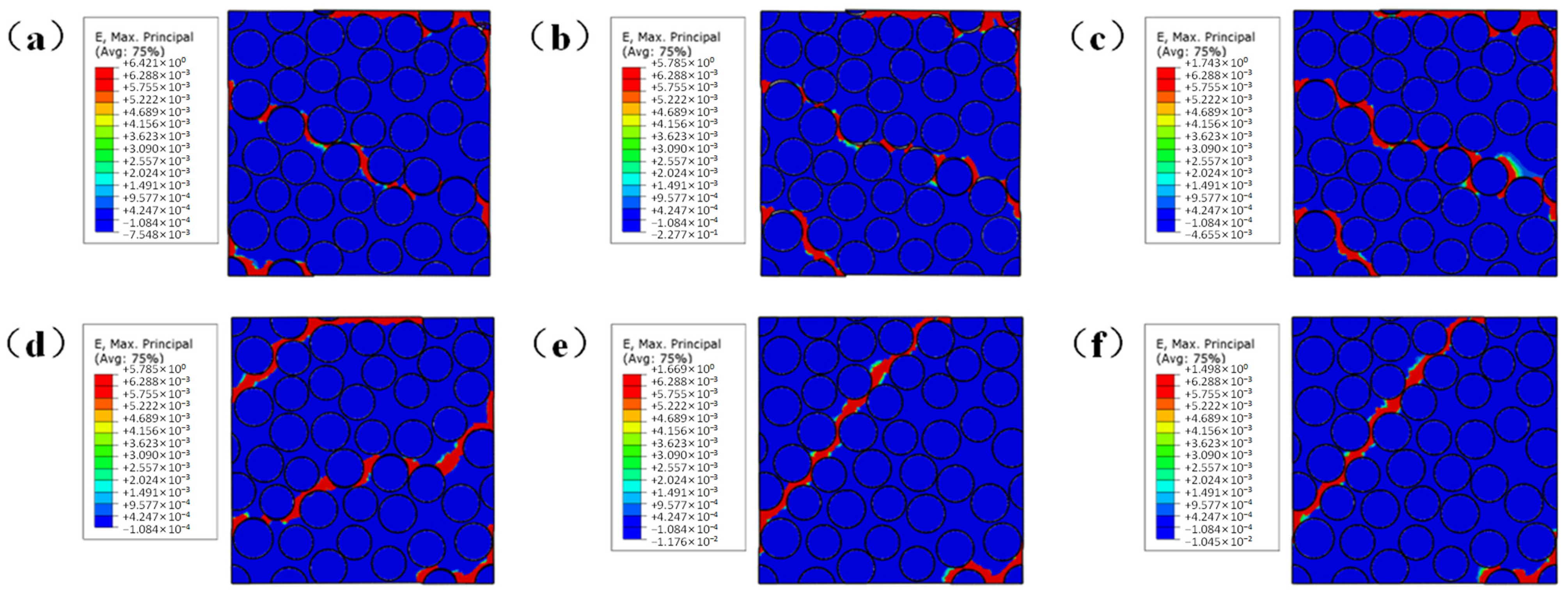


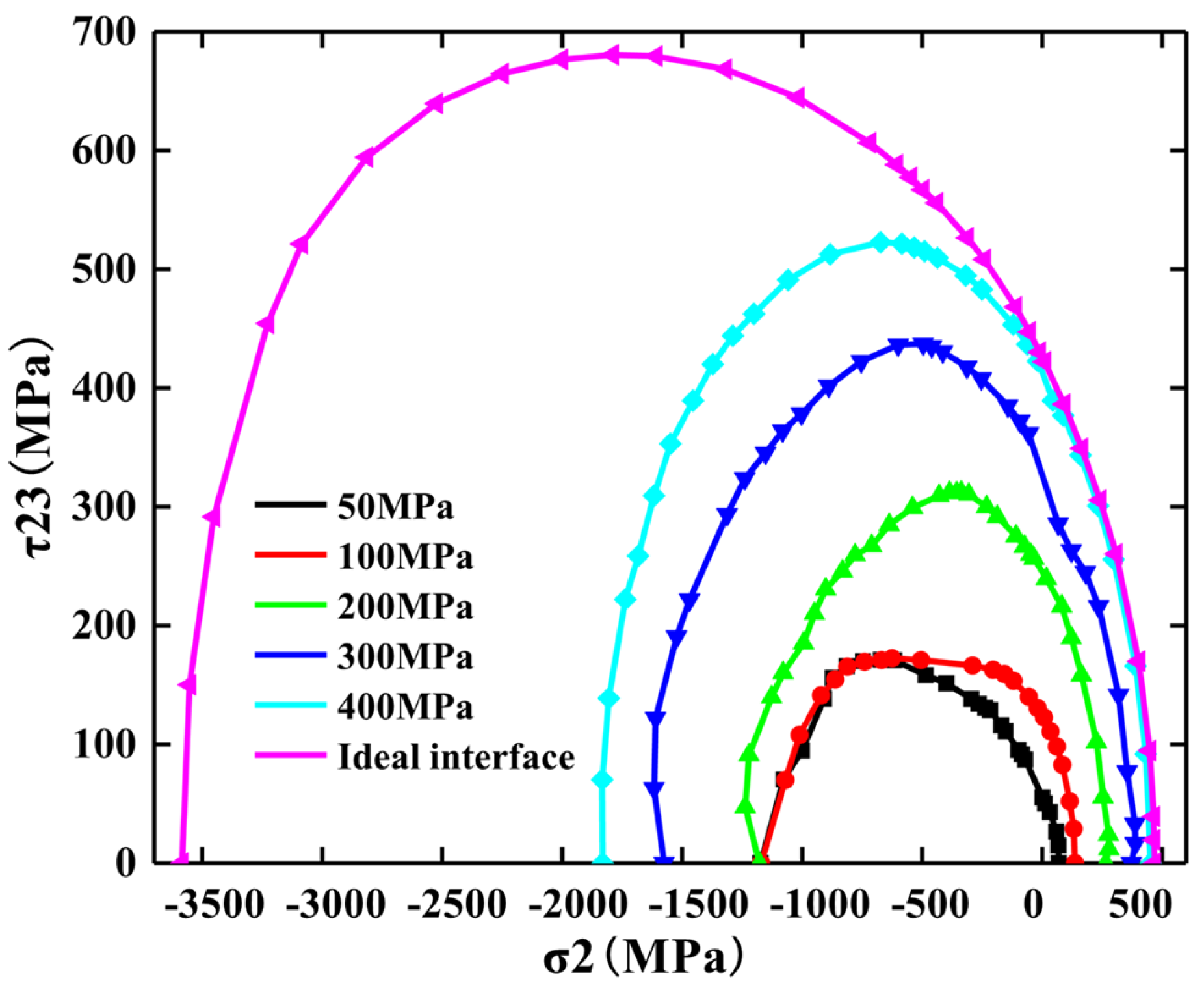
| Parameter | Symbol | Value |
|---|---|---|
| Young’s modulus of silicon carbide fibers | Ef | 380 GPa |
| Poisson’s ratio of silicon carbide fibers | vf | 0.17 |
| Young’s modulus of silicon carbide matrix | Em | 460 GPa |
| Poisson’s ratio of silicon carbide matrix | Vm | 0.21 |
| Tensile strength of silicon carbide fibers | 2.8 GPa | |
| Tensile strength of silicon carbide matrix | 500 MPa | |
| Compressive strength of silicon carbide matrix | 4.2 GPa | |
| Shear strength of silicon carbide matrix | 446.7 MPa | |
| interfacial stiffness | K | 5 × 106 (N/mm) |
| Fracture toughness of silicon carbide matrix | Gm | 20 J/m2 |
| Chamis model | 420.000 | 395.504 | 167.906 | 167.906 | 0.186 | 0.178 |
| RVE-1 | 412.247 | 404.780 | 172.078 | 170.923 | 0.184 | 0.184 |
| RVE-2 | 412.578 | 404.905 | 172.105 | 171.021 | 0.184 | 0.184 |
| RVE-3 | 412.875 | 404.897 | 172.101 | 171.010 | 0.184 | 0.184 |
| YT (MPa) | YC (MPa) | S23 (MPa) | S12 (MPa) | |
|---|---|---|---|---|
| Chamis model | 518.379 | 4354.380 | 459.993 | 459.993 |
| RVE-1 | 468.536 | 3584.020 | 426.844 | 427.388 |
| RVE-2 | 465.612 | 3588.000 | 428.288 | 425.496 |
| RVE-3 | 468.880 | 3589.940 | 427.060 | 426.856 |
Disclaimer/Publisher’s Note: The statements, opinions and data contained in all publications are solely those of the individual author(s) and contributor(s) and not of MDPI and/or the editor(s). MDPI and/or the editor(s) disclaim responsibility for any injury to people or property resulting from any ideas, methods, instructions or products referred to in the content. |
© 2024 by the authors. Licensee MDPI, Basel, Switzerland. This article is an open access article distributed under the terms and conditions of the Creative Commons Attribution (CC BY) license (https://creativecommons.org/licenses/by/4.0/).
Share and Cite
Yan, W.; Shi, S.; Xiao, L.; Li, X.; Xu, J. The Influence of the Interface on the Micromechanical Behavior of Unidirectional Fiber-Reinforced Ceramic Matrix Composites: An Analysis Based on the Periodic Symmetric Boundary Conditions. Symmetry 2024, 16, 695. https://doi.org/10.3390/sym16060695
Yan W, Shi S, Xiao L, Li X, Xu J. The Influence of the Interface on the Micromechanical Behavior of Unidirectional Fiber-Reinforced Ceramic Matrix Composites: An Analysis Based on the Periodic Symmetric Boundary Conditions. Symmetry. 2024; 16(6):695. https://doi.org/10.3390/sym16060695
Chicago/Turabian StyleYan, Wei, Shilun Shi, Longcheng Xiao, Xiulun Li, and Jian Xu. 2024. "The Influence of the Interface on the Micromechanical Behavior of Unidirectional Fiber-Reinforced Ceramic Matrix Composites: An Analysis Based on the Periodic Symmetric Boundary Conditions" Symmetry 16, no. 6: 695. https://doi.org/10.3390/sym16060695




